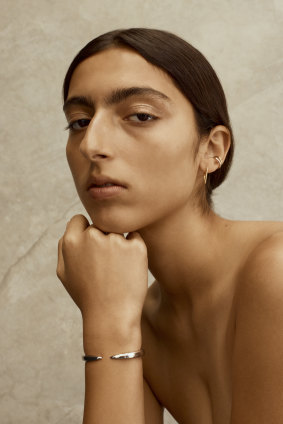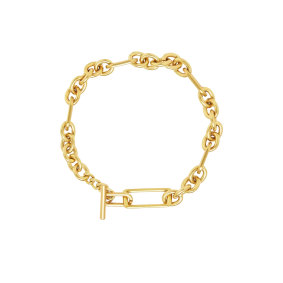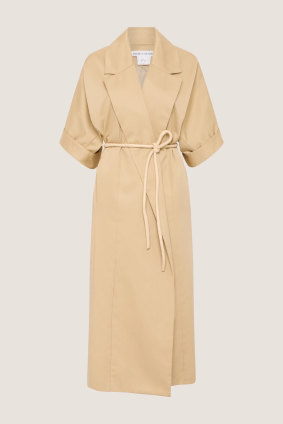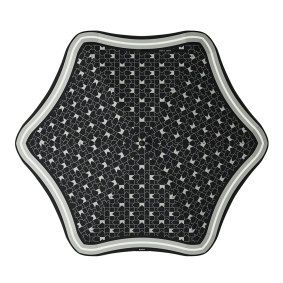This was published 6 months ago
The fashion designers thinking beyond the clothing rack in remarkable ways
By Jane Rocca
Sener Besim

In 2020, Sener Besim launched a jewellery line.
Innovation has always been central to what I do and I’ve created a brand that sits outside seasonality. I launched the business in 2016, starting with Japanese titanium eyewear. My ambition was always to work with Japanese artisans at the top of their game. We were excited to deliver innovation to the independent luxury space as I felt eyewear had been an afterthought for many luxury houses.
In 2020, we launched a jewellery line, working with gold and plated metals and exploring enamelling, which took us on a journey of working with colour. Again we weren’t satisfied with the existing state of affairs.
As we continued to tell our story through our product, we went back to where it started for me – ready-to-wear. I approached the finest mills in Italy to create the highest-quality garments, including knitted skirts and dresses. This year, our second collection has seen us join forces with a Turkish mill to produce a collection of T-shirts, skirts and dresses in black and white. All are made from the same yarn, a high-grade mercerised cotton that can be washed and worn without altering shape.
We’ve also invested in a laser engraver for a customisation program at Mecca, opening in early 2025. The machine itself looks like something out of a Stanley Kubrick’s 2001: A Space Odyssey, one of my biggest influences. We will begin with a gold signet ring and tags on a necklace.
So many brands aspire to just sell clothes. We want our clients to buy into the notion of independent luxury, supporting true innovation, artistic endeavour and looking for something beyond the ordinary.
Cheryl Manning (Manning Cartell)
I started Manning Cartell with my sisters Gabrielle and Vanessa 18 years ago as a clothing label. We launched jewellery into the brand five years ago, and update the hardware for our garments constantly. It’s how we push ourselves with innovation.
Bold statement jewellery, designed in Sydney and manufactured in Bali, is key for us. I play with moulds and create buttons, buckles and baubles for points of difference. Art inspires my designs and gives me the opportunity to look at innovative ways to deliver product.

Manning Cartell’s “bold” jewellery is designed in Sydney and made in Bali.
I am studying fine art on the weekends, and that’s seen us expand into collaborating with artists. It began with the prints of John Coburn for two collections, then a season with Nathan Patterson, and then our latest collection with Melbourne abstract expressionist painter Kerry Armstrong.
Manning Cartell has always been about pushing boundaries, and working to scale with an artist’s prints in clothing take skill and creativity. I do sometimes think about starting a swimwear line. I don’t think anybody is offering bold and sexy swim pieces and telling that story.
Bianca Spender
I made a commitment to use dead stock in 2018 and set a quota that 50 per cent of the styles at Bianca Spender had to be created from disused fabrics. Fabrics used to get burnt, or sit in factories for a long time, but now we are seeing a second market for dead-stock fabrics and that excites me.
We had to shift the way we were thinking about designing garments as a result. It’s like making a meal out of the ingredients you have in your fridge. We have two suppliers who travel sourcing the fabrics, perhaps left over from Marc Jacobs or Tory Burch collections, or whichever designers they can get their hands on.

This coat from Bianca Spender was made using “remnant material”.
I am committed to using this precious resource. Fashion’s greatest impact in terms of carbon footprint has always been the fabric, so I see it as a real obligation to re-use it. It’s such a mind shift for us to have limited resources rather than any amount we want.
I believe in creativity, and having this limitation in fabric makes you more ingenious. Some seasons I find great wool but nothing that has stretch, so I have to rethink which designs will work. It’s all about responding to ingredients.
There’s always a narrative in my collections. The last one centred around the idea of softness. So, when I look for dead-stock fabrics, I hunt for those that have a roundness rather than angular shapes. Sometimes I have to splice up fabrics because there’s not enough to make one garment.
We’ve phased out synthetic materials from our collections and integrated fabrics made in Australia from knit mills such as MTK in Melbourne, who also sell to Balenciaga and Celine. I am all about supporting the full chain.
Karen Walker

Karen Walker has collaborated with Blunt Umbrellas for eight years.
One of the reasons we’re still in business after more than 35 years is because we keep innovating. You don’t get to have a long career if you don’t build that into your practice. You have to constantly pre-empt change before it hits you on the back of your head.
We are now in our seventh season with New Zealand’s Blunt Umbrellas. I wouldn’t try to make an umbrella that can withstand 130km/h winds, but I do like collaborating on prints. And I’ve collaborated with Fijian artisans Rise Beyond the Reef, using their crafts and materials, including native pandanus leaf, to create bags. Their skill set is so unique and innovative.
I also work with Australian brands Outland Denim and Papinelle Sleepwear. The latter came about when our teams met in an airline lounge, leading to this beautiful relationship. They bring real skill around making a perfect pyjama and we bring our intensity of colour to give it a fresh look.
At Karen Walker, we make ready-to-wear, jewellery, bags, shoes and eyewear. It hasn’t just been about clothes for a long time. It’s fashion, and you have to keep throwing yourself forward. Technology changes all the time, and you have to move with that. I use biodegradable acetate for our eyewear. If the glasses break beyond repair, you can put them in the bin and they won’t take 5000 years to break down. Innovation, to me, is about being responsible with your decision-making.
Get the best of Sunday Life magazine delivered to your inbox every Sunday morning. Sign up here for our free newsletter.